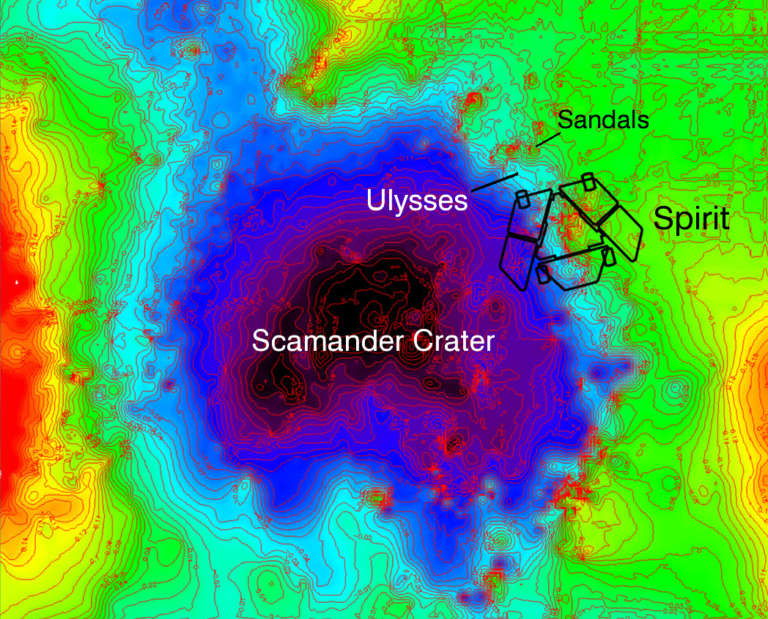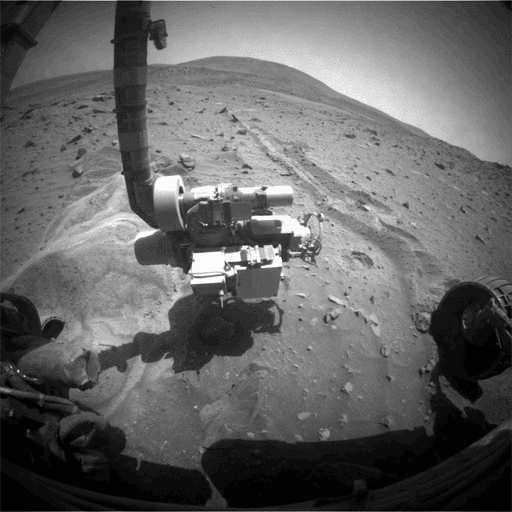Emily Lakdawalla • Nov 12, 2009
Highlights from today's Spirit press briefing
Since A. J. S. Rayl was also listening in on today's press briefing about the efforts to extricate Spirit from her predicament at Troy, I'll just hit the high points and send you over to her story when she has posted it.
But first, an amused comment on the makeup of the panel. It was opened by Doug McCuistion from NASA Headquarters, whose script seems to have required him to knock out all hopes for success among the listening audience. He said such things as "Unfortunately, Spirit may have met its match" and "This could end up being where Spirit remains" and "The plan is to send the first commands on Monday, but this process could take quite a while, if it's possible at all to get Spirit out of its predicament." His comments sounded like the warmup to a eulogy. Project manager John Callas and rover driver Ashley Stroupe were more focused on the present: here's the situation, and here's what we're trying next. And then there was Ray Arvidson, deputy project scientist, who neatly balanced McCuistion's pessimism with equal and opposite optimism: he said that while the science from their current position was exciting, "We're ready to button up here and start driving Monday and head to points south."
The most useful graphic from today's press briefing was this one:

What they have learned is the following.
- Spirit's left wheels appear to have broken through a "duricrust" into a soft sand that is the most sulfate-rich material either rover has studied on Mars.
- That soft sand appears to fill a small crater that was invisible visually and which is only revealed by looking at its subtle topography.
- The right-side wheels, which include the stuck right-front wheel, are outside the crater, on firmer ground.
- The contrast between the two types of soils -- inside the crater and outside -- has been confirmed by using the RAT brush to expose fresh soil in two spots in front of the rover. Toward the rover's left, the RAT brush exposed sulfate-rich soil; toward the rover's right, it did not see this sulfate-rich soil.
- After all their testing, John Callas said, "We haven't found a clear solution to how to get Spirit out of its predicament." But he went on to say "if there is a way out, we will find it."
- Their best plan now is to attempt to drive the rover forward -- which is to say, to drive over the tracks it left as it entered Troy, since the rover was (as usual) driving backward at the time it got stuck.
- Forward is better because that way it doesn't have to climb vertically up onto unbroken duricrust -- they will be going over level ground of the previous tracks, and eventually will even be heading downhill (assuming they make some progress).
- The first wheel motion I noted earlier this week was to straighten wheels into the direction they need to roll next.
- The first drive will be attempted late Monday night, California time, and will consist of just a few meters of commanded drive. They'll have the results back on Tuesday and will take "at least a day" to analyze the results of this first cautious drive.
- This process will take a very long time, even if progress is being made. The next time Headquarters will get involved is at the previously planned Senior Review in February. Rover team will present their progress then and a decision will be taken whether to continue extrication efforts or operate Spirit as a lander mission. Shutting Spirit down is not currently on the table.
- If they do get out, the plan remains to continue south to Von Braun and Goddard.
- Under current conditions, Spirit should have enough power to survive the next winter.
More from A. J. S. Rayl to come.

Support our core enterprises
Your support powers our mission to explore worlds, find life, and defend Earth. You make all the difference when you make a gift. Give today!
Donate

 Explore Worlds
Explore Worlds Find Life
Find Life Defend Earth
Defend Earth

